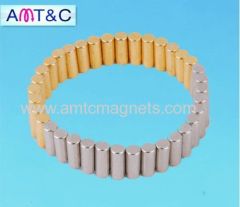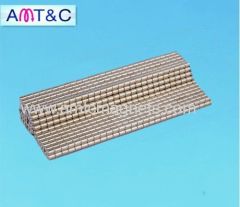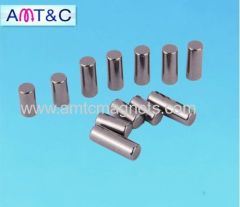


Neodymium (NdFeb) Disc magnet 10(+0/-0.1) x h10(+/-0.1)
10.0~100.0 USD
| Min. Order: | 100 Piece/Pieces |
|---|---|
| Trade Term: | FOB |
| Payment Terms: | T/T |
| Supply Ability: | 500000pcs/month |
| Place of Origin: | Zhejiang |
Company Profile
| Location: | Ningbo, Zhejiang, China (Mainland) |
|---|---|
| Business Type: | Manufacturer, Trading Company |
| Main Products: | Cup Magnets, Coating NdFeB Magnets, Ceramic Magnet, Cylinder NdFeB Magnet Neodymium Rare Earth Permanent Magnet, Countersunk Pot Magnet |
Product Detail
| Means of Transport: | Ocean, Air, Land |
|---|---|
| Application: | Industrial Magnet |
| Shape: | Disc |
| Type: | Permanent |
| Composite: | Neodymium Magnet |
| Grade: | N33 |
| Size: | 10(+0/-0.1) x h10(+/-0.1) |
| coating: | Ni coating |
| Production Capacity: | 500000pcs/month |
| Packing: | according to consumers' need |
| Delivery Date: | within 30 days |
Product Description
Magnet disc
1. Materials: Sintered Neodymium-Iron-Boron, rare earth NdFeB disc magnets;
2. Technology: Utilizes new Sintered NdFeB magnet techniques and equipment such as strip casting, HDDR technology;
3. Magnetic properties: High coercive force, the max operation temp is up to 200 degree centigrade or 380 curie temperature;
4. Grades: N33-N52,33M-48M,33H-48H,30SH-45SH,30UH-38UH and 30EH-35EH;
5. Shapes and sizes: Various kinds or according to customers' request;
6. Coatings: Ni, Zn, gold, copper, epoxy, chemical, parylene and so on;
7. Certification:ISO9001:2008 and ISO/TS16949:2009.
8. Applications of the Disc magnet: Widely used in different applications, such as sensors, motors, rotors, wind turbines/wind generators, loudspeakers, magnetic hooks, magnetic holder, filters automobiles and so on
Introduction to Neodymium Magnets
Neodymium Iron Boron, NdFeB, magnets are the strongest magnets available.
Like Samarium Cobalt, NdFeB is termed a Rare Earth magnet. The Neodymium Iron Boron, NdFeB, magnets are made of an alloy primarily consisting of Neodymium, Iron and Boron and the alloy is chemically written as Nd2Fe14B. Although Neodymium Iron Boron is often written as NdFeB or Neodymium, it is often given the nickname of "Neo" and, very infrequently, "NIB".
Up to +150 degrees C, the Neodymium Iron Boron magnets are the strongest performers. Between +130 degrees C and +160 degrees C, there is an overlap in performance between NdFeB and SmCo. Above +150 degrees C SmCo provides the greater performance.
The "Neo" magnets are a first choice for many applications as they offer the greatest performance with the smallest volume. Neodymium Iron Boron, NdFeB, magnets exist in a variety of grades. These grades not only vary in magnetic output performance but they also vary with temperature rating. The maximum recommended temperature of operation for the "Neo" magnets is +200 to +230 degrees C although the exact limit is actually dependent on the magnet shape and the total magnetic circuit (so the recommended limits are really only crude guideline values). This is discussed in the section called Temperature Ratings.
All the Neodymium Iron Boron, NdFeB, magnets are prone to corrosion (a method similar to rusting). All Neodymium Iron Boron, NdFeB, magnets will require a form of protective coating. The standard coating is a triple layer plating of Nickel-Copper-Nickel (Ni-Cu-Ni). Unless requested otherwise, this Ni-Cu-Ni coating is always applied to the magnets. It should be noted that the level of protection given by any coating depends on the environment the magnet will be subjected to and how the coating is looked after.
The magnetic output from the "Neo" magnet varies with temperature. The output falls with increasing temperature but usually returns as it cools (the degree of fall with rising temperature is dependent on the reversible temperature coefficients). It is possible to permanently reduce the magnetic output through too high a temperature (a permanent demagnetisation).
The level of permanent demagnetisation depends on the magnet shape, the total magnetic circuit and the actual shape of the BH curve (which will vary depending on the grade of "Neo" chosen). Neodymium Iron Boron, NdFeB, magnets are also affected by external demagnetisation fields and by radiation, both of which can demagnetise the magnet, the latter permanently demagnetising.
If the user understands the limitations of NdFeB and understands their application, the use of NdFeB magnets can allow very compact designs with high performance with issues affecting the performance. For note, if the magnet is kept in dry conditions at all times and the plating is not broken and no external demagnetising fields are applied to it, the magnet theoretically can retain its magnetism indefinitely.
The next sections will show you how NdFeB magnets are made, the grades available, the effects of temperature and how to use plus get the most out of NdFeB.

